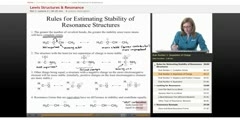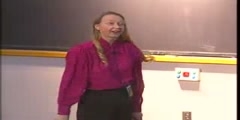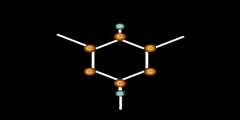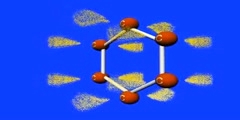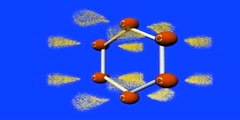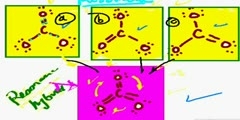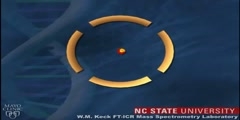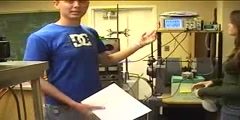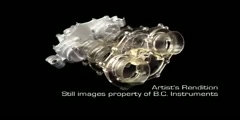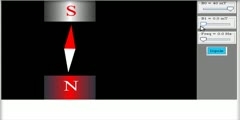Lec 2 - Force Laws, Lewis Structures and Resonance
"Lec 2 - Force Laws, Lewis Structures and Resonance" Freshman Organic Chemistry (CHEM 125) Professor McBride begins by following Newton's admonition to search for the force law that describes chemical bonding. Neither direct (Hooke's Law) nor inverse (Coulomb, Gravity) dependence on distance will do - a composite like the Morse potential is needed. G. N. Lewis devised a "cubic-octet" theory based on the newly discovered electron, and developed it into a shared pair model to explain bonding. After discussing Lewis-dot notation and formal charge, Professor McBride shows that in some "single-minimum" cases the Lewis formalism is inadequate and salvaging it required introducing the confusing concept of "resonance." 00:00 - Chapter 1. Newton's "Additions": An Inquiry into Small Forces 09:15 - Chapter 2. Is there a Chemical Force Law? 18:26 - Chapter 3. The Morse Potential 21:42 - Chapter 4. What are Bonds? Early Understandings of Valence 32:52 - Chapter 5. Deriving Structure and Reactivity from Valence Electrons Complete course materials are available at the Open Yale Courses website: http://open.yale.edu/courses This course was recorded in Fall 2008.
Video is embedded from external source so embedding is not available.
Video is embedded from external source so download is not available.
Channels: Chemistry (General)
Tags: Morse Potential Lewis-dot Formal Charge Resonance Equilibrium
Uploaded by: yalefreshorganic ( Send Message ) on 05-09-2012.
Duration: 50m 13s
Here is the next lecture for this course
Chemical Science - Lewis Diagrams - Lectu ...
45:49 | 12899 viewsResonance Structures
06:00 | 6899 viewsLec 100 - Lewis Electron Dot Structures
02:03 | 2921 viewsLec 3 - Double Minima, Earnshaw's Theorem ...
45:03 | 2684 viewsChemical Science - Breakdown of Octet Rul ...
50:10 | 16306 viewsVague Idea of Benzene Resonance
00:05 | 14364 viewsUnderstanding Benzene Resonance with Pi-bonds
00:13 | 12244 viewsResonance Structure of Benzene
00:13 | 30444 viewsResonance
08:27 | 7297 viewsMass Spectrometry- Ion Cyclotron Resonance
01:21 | 9253 viewsNuclear Magnetic Resonance
04:15 | 5128 viewsMagnetic Resonance Imaging
06:41 | 5906 viewsMeet the SAM Team Jesse Lewis
01:49 | 2928 viewsMagnetic resonance as used in NMR and MRI
05:09 | 5160 viewsNuclear Magnetic Resonance NMR
08:43 | 9298 viewsNo content is added to this lecture.
This video is a part of a lecture series from of Yale
Lecture list for this course
Lec 3 - Double Minima, Earnshaw's Theorem and Plum-Puddings
Lec 4 - Coping with Smallness and Scanning Probe Microscopy
Lec 6 - Seeing Bonds by Electron Difference Density
Lec 7 - Quantum Mechanical Kinetic Energy
Lec 8 - One-Dimensional Wave Functions
Lec 9 - Chladni Figures and One-Electron Atoms
Lec 10 - Reality and the Orbital Approximation
Lec 11 - Orbital Correction and Plum-Pudding Molecules
Lec 12 - Overlap and Atom-Pair Bonds
Lec 13 - Overlap and Energy-Match
Lec 14 - Checking Hybridization Theory with XH_3
Lec 15 - Chemical Reactivity: SOMO, HOMO, and LUMO
Lec 16 - Recognizing Functional Groups
Lec 17 - Reaction Analogies and Carbonyl Reactivity
Lec 18 - Amide, Carboxylic Acid and Alkyl Lithium
Lec 19 - Oxygen and the Chemical Revolution (Beginning to 1789)
Lec 20 - Rise of the Atomic Theory (1790-1805)
Lec 21 - Berzelius to Liebig and Wöhler (1805-1832)
Lec 22 - Radical and Type Theories (1832-1850)
Lec 23 - Valence Theory and Constitutional Structure (1858)
Lec 24 - Determining Chemical Structure by Isomer Counting (1869)
Lec 25 - Models in 3D Space (1869-1877); Optical Isomers
Lec 26 - Van't Hoff's Tetrahedral Carbon and Chirality
Lec 27 - Communicating Molecular Structure in Diagrams and Words
Lec 28 - Stereochemical Nomenclature; Racemization and Resolution
Lec 29 - Preparing Single Enantiomers and the Mechanism of Optical Rotation
Lec 30 - Esomeprazole as an Example of Drug Testing and Usage
Lec 31 - Preparing Single Enantiomers and Conformational Energy
Lec 32 - Stereotopicity and Baeyer Strain Theory
Lec 33 - Conformational Energy and Molecular Mechanics
Lec 34 - Sharpless Oxidation Catalysts and the Conformation of Cycloalkanes
Lec 35 - Understanding Molecular Structure and Energy through Standard Bonds
Lec 36 - Bond Energies, the Boltzmann Factor and Entropy
Lec Last - Potential Energy Surfaces, Transition State Theory and Reaction Mechanism


